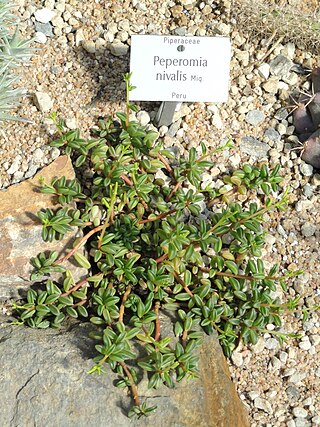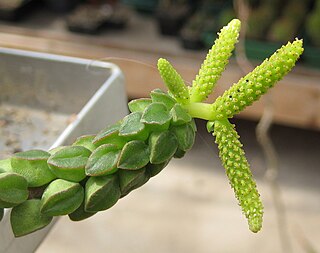
Peperomia is one of the two large genera of the family Piperaceae. It is estimated that there are at least over 1,000 species, occurring in all tropical and subtropical regions of the world. They are concentrated in South and Central America, but may also be found in southern North America, the Caribbean islands, Africa, Oceania, and southern and eastern parts of Asia. The exact number of species is difficult to determine, as some plants have been recorded several times with different names, and new species continue to be discovered. Peperomias have adapted to many different environments and their appearances vary greatly. Some are epiphytes or lithophytes, and many are xerophytes or possess underground tubers (geophytes). Most species are compact perennial shrubs or vines.

A houseplant, sometimes known as a pot plant, potted plant, or an indoor plant, is an ornamental plant that is grown indoors. As such, they are found in places like residences and offices, mainly for decorative purposes. Common houseplants are usually tropical or semi-tropical, and are often epiphytes, succulents or cacti.

Lithops is a genus of succulent plants in the ice plant family, Aizoaceae. Members of the genus are native to southern Africa. They avoid being eaten by blending in with surrounding rocks and are often known as pebble plants or living stones.

Peperomia graveolens, commonly known as Ruby Glow, is a species of plant in the genus Peperomia of the family Piperaceae. It is endemic to Ecuador.

Peperomia nivalis is a species of plant in the genus Peperomia endemic to Peru. Its native habitat is found in the high altitude ranges of the peruvian Andes. P. nivalis is a compact erect succulent herb with fleshy stems and leaves. The thick leaves are cuneate and U-shaped in cross-section with epidermal windows on the top-side. The leaf color is bright green in the shady summer and reddish during dry sunny seasons.

In botany, succulent plants, also known as succulents, are plants with parts that are thickened, fleshy, and engorged, usually to retain water in arid climates or soil conditions. The word succulent comes from the Latin word sucus, meaning "juice" or "sap".

Peperomia columella is a species of plant in the family Piperaceae. The species is endemic to Peru. It grows in dry areas, often in crevices on steep cliffs or in sandy soil. It grows to about 20 cm in height, forming snake-like stems, which carry closely packed succulent bright green leaves. The leaves are truncated, U-shape in cross-section, with epidermal windows on top. It can be kept as a houseplant and has received the Award of Garden Merit by the Royal Horticultural Society.

Peperomia tetraphylla, known as the acorn peperomia or four-leaved peperomia, is a small plant in the Piperaceae family that grows natively in tropical and subtropical regions around the world. It has been introduced to Easter Island.

Peperomia obtusifolia, also known as the baby rubberplant, American rubber plant, or pepper face, is a species of flowering plant in the genus Peperomia under the family Piperaceae, native to Florida, Mexico and the Caribbean. The specific epithet obtusifolia means "blunt-leaved". The plant has gained the Royal Horticultural Society's Award of Garden Merit.

Crassula ovata, commonly known as jade plant, lucky plant, money plant or money tree, is a succulent plant with small pink or white flowers that is native to the KwaZulu-Natal and Eastern Cape provinces of South Africa, and Mozambique; it is common as a houseplant worldwide. Much of its popularity stems from the low levels of care needed; the jade plant requires little water and can survive in most indoor conditions. It is sometimes referred to as the money tree; however, Pachira aquatica also has this nickname.

Leaf window, also known as epidermal window, and fenestration, is a specialized leaf structure consisting of a translucent area through which light can enter the interior surfaces of the leaf where photosynthesis can occur. The translucent structure may include epidermal tissue, and in some succulent plants it consists of several cell layers of parenchyma, which may also function as water-storage tissue. It can appear as a large continuous patch, a variegated or reticulated region, or as numerous small spots. It is found in some succulent plants native to arid climates, allowing much of the plant to remain beneath the soil surface where it is protected from desiccation by winds and heat while optimizing light absorption. Many species featuring leaf windows are native to Southern Africa.

Peperomia ferreyrae is a species of plant in the genus Peperomia native to Peru. It is a small, succulent herb, growing erect to about 20 cm in height. The alternating, typically 3 to 5 cm long leaves, are in the form of tubes resembling green bean pods: U-shaped in cross-section with epidermal windows on the top-side.

Peperomia magnoliifolia, commonly known as the spoonleaf peperomia, is a species of plant in the genus Peperomia. Its native range reaches from parts of southern Florida and Mexico to the Caribbean and northern South America including Uruguay.

Peperomia fraseri, commonly known as the flowering pepper, is a species of plant in the genus Peperomia of the family Piperaceae. Its native range covers Colombia and Peru. It has also been introduced to Ecuador and Guatemala.

Peperomia quadrangularis, commonly known as the beetle peperomia, is a species of plant in the genus Peperomia of the family Piperaceae. Its native range is in tropical America, including areas in northern South America, Central America and the West Indies.
Peperomia kimnachii is a species of plant in the genus Peperomia of the family Piperaceae. It is native to Bolivia, often growing as an epiphyte.

Peperomia verticillata is a species of plant in the genus Peperomia of the family Piperaceae. It is native to the Caribbean islands.

Peperomia polybotrya, commonly known as raindrop peperomia or raindrop plant, is a species of perennial plant in the genus Peperomia of the family Piperaceae. It is native to Colombia, Ecuador, and Peru.
Peperomia wolfgang-krahnii is a succulent species of plant endemic to the country of Peru. It has grey-green leaves that can have 5 inches of the shrub. Leaves alternate from the top being grey-greened and warty, while the bottom is folded with smooth and shiny leaves.

Peperomia enervis is a plant in the pepper family Piperaceae found only in rainforests of northeast Queensland near the cities of Cairns and Mackay. It was first described in 1891.


















